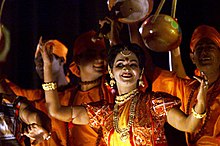The music and dance styles of Bangladesh may be divided into three categories: classical, folk, and modern. The classical style has been influenced by other prevalent classical forms of music and dances of the Indian subcontinent, and accordingly show some influenced dance forms likeBharata Natyam and Kuchipudi. The folk and tribal music and dance forms of Bangladesh are of indigenous origin and rooted to the soil of Bangladesh. Several dancing styles in vogue in the north-eastern part of the Indian subcontinent, like monipuri and santal dances, are also practiced in Bangladesh, but Bangladesh has developed its own distinct dancing styles. Bangladesh has a rich tradition of folk songs, with lyrics rooted into vibrant tradition andspirituality, mysticism, and devotion. Such folk songs also revolve round several other themes, including love themes. Most prevalent of folk songs and music traditions include Bhatiali, Baul, Marfati, Murshidi, and Bhawaiya. Lyricists like Lalon Shah, Hason Raja, Kangal Harinath, Romesh Shill, Abbas Uddin, and many unknown anonymous lyricists have enriched the tradition of folk songs of Bangladesh. In relatively modern context, Robindro Shongit and Nazrul Giti form precious cultural heritage of Bangladesh. In recent time, western influences have given rise to several quality rock bands, particularly in urban centers like Dhaka. Several musical instruments, some of them of indigenous origin, are used in Bangladesh, and major musical instruments used are the bamboo flute (bashi), drums (dhol), a single stringed instrument named ektara, a four stringed instrument called dotara, and a pair of metal bawls used for rhythm effect called mandira, are important in the culture of Bangladesh. Currently, several musical instruments of western origin like guitars, drums, and the saxophone are also used, sometimes along with traditional instruments.(Muajj)
Friday, March 18, 2016
Pohela Boishakh
Main article: Pohela Boishakh
Pôhela Boishakh is the first day of the Bengali calendar. It is usually celebrated on 14 April. Pohela Boishakh marks the start day of the crop season. Usually on Pôhela Boishakh, the home is thoroughly scrubbed and cleaned; people bathe early in the morning and dress in fine clothes. They spend much of the day visiting relatives, friends, and neighbours and going to the fair. Fairs are arranged in many parts of the country where various agricultural products, traditional handicrafts, toys, cosmetics, as well as various kinds of food and sweets are sold. The fairs also provide entertainment, with singers, dancers and traditional plays and songs. Horse races, bull races, bullfights,cockfights, flying pigeons, and boat racing were once popular. All gatherings and fairs consist a wide spread of Bengali food and sweets. The most colourful New Year's Day festival takes place in Dhaka. Large numbers of people gather early in the morning under the banyan tree at Ramna Park where Chhayanat artists open the day with Rabindranath Tagore's famous song, Esho, he Boishakh, Esho esho(Come, year, come, come). A similar ceremony welcoming the new year is also held at the Institute of Fine Arts (Dhaka) and University of Dhaka. Students and teachers of the institute take out a colourful procession and parade to round the campus. Social and cultural organisations celebrate the day with cultural programmes. Newspapers bring out special supplements. There are also special programmes on radio and television. Prior to this day, special discounts on clothes, furniture, electronics and various deals and shopping discounts are available. Special line ofsaree, usually cotton, white sarees with red print and embroidery is sold before this day as everyone dresses up for this day. Jasmine flowers are also a huge sale for this event which adorns the women's hair.
Subscribe to:
Comments (Atom)

